Click on images to enlarge
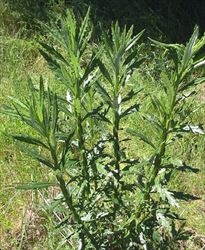
habit prior to flowering (Photo: Sheldon Navie)

winged stems and lower stem leaves (Photo: Sheldon Navie)
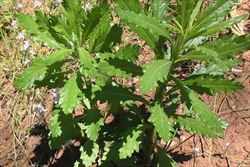
deeply-toothed leaves (Photo: Sheldon Navie)
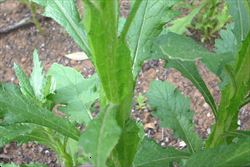
close-up of winged stems and lower stem leaves (Photo: Sheldon Navie)
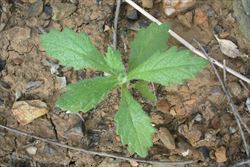
seedling (Photo: Sheldon Navie)
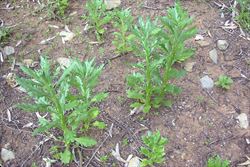
young plants (Photo: Sheldon Navie)
Scientific Name
Senecio pterophorus DC.
Family
Asteraceae (Queensland, New South Wales, the ACT, Victoria, Tasmania, Western Australia and the Northern Territory)Compositae (South Australia)
Common Names
African daisy, South African daisy, winged groundsel
Origin
Native to southern Africa.
Naturalised Distribution
This species is most common in the south-eastern parts of South Australia, where it is quite widespread and abundant. It is also relatively common in the southern and western regions of Victoria and is scattered along the central coast of New South Wales.
Habitat
A weed of grasslands, pastures, roadsides, disturbed sites, waste areas and forest margins in temperate and sub-tropical regions.
Habit
An upright (i.e. erect) herbaceous plant or small bushy shrub usually growing 1-1.5 m tall, but occasionally reaching up to 3 m in height.
Distinguishing Features
- an upright herbaceous plant or small bushy shrub usually growing 1-1.5 m tall.
- its greyish-green stems that are ribbed lengthwise and the lower parts of the stems develop distinctive toothed 'wings'.
- these 'wings' extend down from the bases of the lance-shaped leaves.
- these leaves have coarsely toothed or entire margins, green upper surfaces, and whitish woolly undersides.
- its small flower-heads (12-15 mm across) have several yellow 'petals' and a darker yellow centre.
- its reddish-brown or dark brown ribbed 'seeds' (1.5-2 mm long) are topped with a ring of silky hairs (up to 5 mm long).
Stems and Leaves
The stems are greyish-green in colour, ribbed lengthwise (i.e. longitudinally) and covered in fine woolly hairs. The lower parts of the stems develop toothed (i.e. serrated) 'wings' and become somewhat woody when the plant is mature.
The alternately arranged leaves (50-120 mm long and 3-25 mm wide) have dark green upper surfaces and whitish woolly undersides (i.e. they are discolorous). They are lance-shaped (i.e. lanceolate) with coarsely toothed (i.e. serrated) to entire margins that are often curled downwards (i.e. revolute). The lower leaves have short stalk-like bases and 'wings' that extend down the stems. However, the uppermost leaves are generally smaller, narrower and stalkless (i.e. sessile).
Flowers and Fruit
The flower-heads (12-15 mm across) are borne in spreading clusters at the tops of the stems. These flower-heads (i.e. capitula) have several (9-13) yellow 'petals' (i.e. ray florets) about 4-7 mm long. They also have numerous (40-95) darker yellow tiny tubular flowers (i.. tubular or disc florets) in the centre and are surrounded by two distinct layers of bracts (i.e. an involucre). The inner bracts (18-22 in number) are larger (4-5 mm long) and taper to a brown hair-like tip, while the outer bracts (i.e. bracteoles) are shorter. Flowering occurs from late spring through until autumn.
The 'seeds' (i.e. achenes) are reddish-brown or dark brown in colour and oblong or cylindrical in shape. These 'seeds' (1.5-2 mm long) are also ribbed lengthwise (i.e. longitudinally) and partially covered in minute hairs or bristles. They are topped with a ring (i.e. pappus) of silky hairs (up to 5 mm long) that are easily shed.
Reproduction and Dispersal
This plant reproduces by seed, and occasionally via crown segments.
Most dispersal is by wind, water, animals and vehicles. However, some spread may also occur or in contaminated soil and agricultural produce.
Environmental Impact
African daisy (Senecio pterophorus) is regarded as an environmental weed in South Australia, and is actively managed by community groups in that state.
Legislation
This species is declared under legislation in the following states and territories:
- Victoria: P6 - prohibited and must be eradicated or controlled (in the Mallee, Wimmera, Glenelg, North Central, Goulburn and North East regions), and C1 - all reasonable steps must be taken to control the weed and prevent its spread (in the Port Phillip East region only).
- Western Australia: Prohibited - on the prohibited species list and not permitted entry into the state.
Management
For information on the management of this species see the following resources:
- the Victorian Department of Sustainability and Environment Landcare Note on this species, which is available online at http://www.dse.vic.gov.au.
Similar Species
African daisy (Senecio pterophorus) is very similar to fireweed groundsel (Senecio linearifolius) and cotton fireweed (Senecio quadridentatus), and relatively similar to variable groundsel (Senecio pinnatifolius), fireweed (Senecio madagascariensis) and ragwort (Senecio jacobaea). These species can be differentiated by the following differences:
- African daisy (Senecio pterophorus) is a tall and long-lived (i.e. perennial) plant (80-150 cm tall). It has elongated (i.e. lanceolate) leaves with toothed or occasionally entire margins. These leaves have mostly hairless upper surfaces and whitish or cobwebby lower surfaces. They have a narrow stalk-like base (i.e. the base is petiole-like) and the stems are winged. Its flower-heads (i.e. capitula) have obvious 'petals' (i.e. ray florets), are usually enclosed in 18-22 bracts (i.e. involucral bracts), and are borne in large spreading clusters.
- fireweed groundsel (Senecio linearifolius) is a tall and long-lived (i.e. perennial) plant (50-150 cm tall). It has elongated (i.e. linear or lanceolate) leaves with entire or sparsely toothed margins. These leaves have hairless (i.e. glabrous) upper surfaces, whitish or cobwebby lower surfaces, and a narrow stalk-like base (i.e. the base is petiole-like) with two small lobes. Its flower-heads (i.e. capitula) have obvious 'petals' (i.e. ray florets), are usually enclosed in 10-12 bracts (i.e. involucral bracts), and are borne in large, relatively dense, clusters.
- cotton fireweed (Senecio quadridentatus) is a tall and long-lived (i.e. perennial) plant (50-120 cm tall). It has very narrow (i.e. linear or narrowly lanceolate) leaves with finely toothed margins that may sometimes appear entire. These leaves have sparsely hairy upper surfaces and whitish or densely cobwebby lower surfaces. Its flower-heads (i.e. capitula) do not have obvious 'petals' (i.e. ray florets), are usually enclosed in 10-13 bracts (i.e. involucral bracts), and are borne in large, relatively loose, clusters.
- variable groundsel (Senecio pinnatifolius) is a low-growing and long-lived (i.e. perennial) plant (10-75 cm tall). It has elongated (i.e. linear or lanceolate), or lobed leaves, with toothed or occasionally entire margins. These leaves have mostly hairless (i.e. glabrous) upper and lower surfaces and the leaves are stem-clasping (i.e. sessile) or appear to have a stalk at the base (i.e. the base is petiole-like). Its flower-heads (i.e. capitula) have obvious 'petals' (i.e. ray florets), are usually enclosed in 15-18 bracts (i.e. involucral bracts), and are borne in loose clusters (containing up to 25 heads).
- fireweed (Senecio madagascariensis) is a low-growing and short-lived (i.e. annual or biennial) plant (20-60 cm tall). It has elongated (i.e. lanceolate), or sometimes lobed, leaves with toothed or occasionally entire margins. These leaves have mostly hairless (i.e. glabrous) upper and lower surfaces and they are stem-clasping (i.e. sessile). Its flower-heads (i.e. capitula) have obvious 'petals' (i.e. ray florets), are usually enclosed in 19-21 bracts (i.e. involucral bracts) and are borne in small loose clusters (containing 2-10 heads).
- ragwort (Senecio jacobaea) is a relatively tall and long-lived (i.e. biennial or perennial) plant (30-150 cm tall). It has deeply divided leaves (i.e. lyrate-pinnatifid or bi-pinnatisect) with irregularly toothed margins. These leaves have hairless (i.e. glabrous) upper surfaces and hairy or cobwebby lower surfaces, and they appear to have a stalk at the base (i.e. the base is petiole-like). Its flower-heads (i.e. capitula) have obvious 'petals' (i.e. ray florets), are usually enclosed in about 13 bracts (i.e. involucral bracts), and are usually borne in large, relatively dense, clusters.

